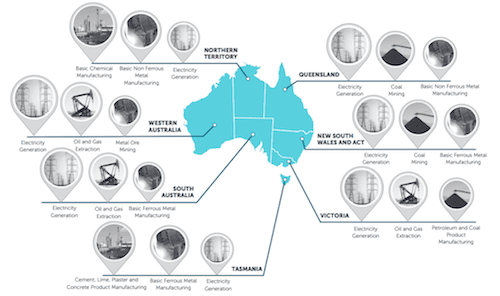Fossil-fueled electricity generation remains Australia’s largest industrial and corporate source of greenhouse gas emissions, responsible for more than half of the carbon pollution emitted nationally last year, new data has shown. 
According to the 2013-14 National Greenhouse and Energy Reporting (NGER) data, published by the federal government’s Clean Energy Regulator late last week, Australia’s power generation companies are still the country’s biggest producers of scope 1 greenhouse gas emissions, with the big three gentailers – EnergyAustralia, AGL Energy and Origin Energy – coming in at numbers 1, 3 and 6 respectively in the rankings for Australia’s most polluting companies.
The data represents the greenhouse gas emissions and net energy consumption for 420 of Australia’s heaviest corporate emitters, who in 2013-14 produced a combined 312 million tonnes of scope 1 emissions (CO2-e), 88 million tonnes of scope 2 emissions (CO2-e), and consumed a net energy equivalent of around 5,150 petajoules.
The below graph (you can click on the image to see a bigger version) narrows it down to the top 20 corporate emitters – most of which hail from the electricity generation, mining and manufacturing sectors –who together represent around 60 per cent of the emissions reported under the NGER Scheme.

And while coal mining accounts for 9 per cent of scope 1 emissions (see top-right pie chart), it is the burning of coal for energy that remains Australia’s dirtiest industry, responsible for a whopping 54 per cent of emissions in 2013-14.
The third chart, below, measures the total emissions produced by the top 20 designated generation facilities against the amount of electricity produced.
As you can see, the ratio between emissions to electricity generation depends largely on the type of fuel the power plant burns. All of Australia’s largest designated generation facilities are coal-fired, but the worst offenders are the brown coal plants, like the AGL-owned Loy Yang A in Victoria, which – as you can see in the chart – remains Australia’s single biggest emitter of greenhouse gases.

And while Victoria boasts the top two most polluting coal-fired power plants in Australia – Hazelwood, owned by GDF Suez, is number two on the list – electricity generation remains the biggest emitter in all but two of Australia’s states and territories. In the Northern Territory, it comes in at number three, after manufacturing, as it does in Tasmania, where hydro-power is the main electricity source.











